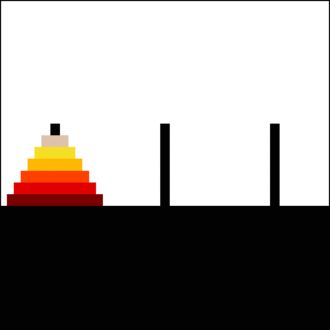Tower of Hanoi is a popular puzzle game for several millennia.
The task:
Three rods are given, on one of which from three to eight disks are strung, the disks differ in size and lie smaller on the larger.
The task is to transfer the pyramid tower in the least number of moves to another rod.
Only one ring can be transferred at a time, and you cannot put a larger ring on a smaller one.
The optimal solution to the task with the disks (rings) of the Brahma tower.
3 disks = 7 moves
4 disks = 15 moves
5 disks = 31 moves
6 disks = 63 moves
7 disks = 127 moves


Legend of the Brahma Tower
Legend said that a long time ago, at the very beginning of time, a monk asked the god of creation Brahma (Hinduism) to create a paradise on earth for all people.
Brahma created three rods, placed only 64 discs on the central one and explained that people are now in the hands of a monk.
The central axis is the balance of power in the world and harmony, the lateral axis is good on the one hand and evil on the other.
In order to create a paradise for people, you need to shift the disks from the central axis to the side, so that each smaller disk lies on a larger one.
Then the monk became the cause of the struggle between good and evil or evil with good. Each moment, disks accumulate on one side, then on the other, then in the center, plunging people into hell, then into paradise, then into equilibrium.
As soon as all 64 discs are shifted from the rod to which Brahma put them when creating the world, to another rod, peace will come among people.
The immortal monk tries to move the disk every second every day and night.
The number of shifts depending on the number of rings is calculated by the formula 2
n-1.
The number of shifts that a monk must make is equal to 18 446 744 073 709 551 615.
His work will be completed in almost 585 billion years.
![]() CY +357-96-38-39-40
CY +357-96-38-39-40
![]() UK +44 754-373-15-03
UK +44 754-373-15-03
 WhatsApp
WhatsApp
 Request
Request
 Chat
Chat
 info@24glo.com
Contacts
info@24glo.com
Contacts
![]() CY +357-96-38-39-40
CY +357-96-38-39-40
![]() UK +44 754-373-15-03
UK +44 754-373-15-03
 WhatsApp
WhatsApp
 Request
Request
 Chat
Chat
 info@24glo.com
Contacts
info@24glo.com
Contacts

